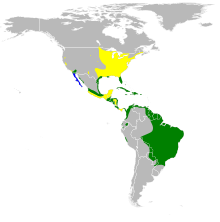
The boat-billed heron, colloquially known as the boatbill, is an atypical member of the heron family. It is the only member of the genus Cochlearius and was formerly placed in a monotypic family, the Cochleariidae. It lives in mangrove swamps from Mexico south to Peru and Brazil. It is a nocturnal bird, and breeds semicolonially in mangrove trees, laying two to four bluish-white eggs in a twig nest.

Steller's jay is a bird native to western North America and the mountains of Central America, closely related to the blue jay found in eastern North America. It is the only crested jay west of the Rocky Mountains. It is also sometimes colloquially called a "blue jay" in the Pacific Northwest, but is distinct from the blue jay of eastern North America. The species inhabits pine-oak and coniferous forests.

Herons are long-legged, long-necked, freshwater and coastal birds in the family Ardeidae, with 72 recognised species, some of which are referred to as egrets or bitterns rather than herons. Members of the genera Botaurus and Ixobrychus are referred to as bitterns, and, together with the zigzag heron, or zigzag bittern, in the monotypic genus Zebrilus, form a monophyletic group within the Ardeidae. Egrets do not form a biologically distinct group from herons, and tend to be named differently because they are mainly white or have decorative plumes in breeding plumage. Herons, by evolutionary adaptation, have long beaks.
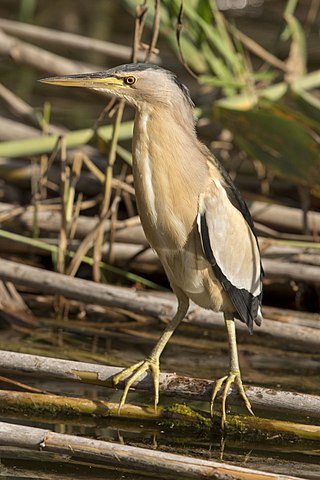
The little bittern or common little bittern is a wading bird in the heron family, Ardeidae. Ixobrychus is from Ancient Greek ixias, a reed-like plant and brukhomai 'to bellow', and minutus is Latin for 'small'.
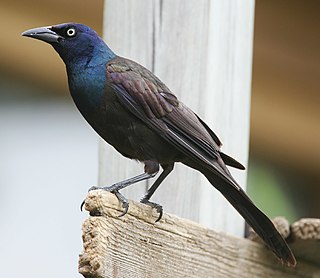
The common grackle is a species of large icterid bird found in large numbers through much of North America. First described in 1758 by Carl Linnaeus, the common grackle has three subspecies. Adult common grackles have a long and dark bill, pale yellow eyes, and a long tail. Adults often have an iridescent appearance on their head, especially males. Common grackles can be found widely across North America east of the Rocky Mountains.
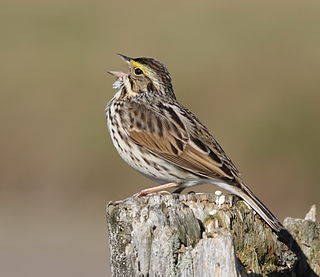
The Savannah sparrow is a small New World sparrow that is the only member of the genus Passerculus. It is a widespread and abundant species that occupies open grassland habitats in North America.

The cinnamon bittern or chestnut bittern is a small Old World bittern, breeding in tropical and subtropical Asia from India east to China and Indonesia. It is mainly resident, but some northern birds migrate short distances.

The yellow bittern is a small bittern. It is of Old World origins, breeding in the northern Indian Subcontinent, east to the Russian Far East, Japan and Indonesia. It is mainly resident, but some northern birds migrate short distances. It has been recorded as a vagrant in Alaska and there is a single sighting in Great Britain, from Radipole Lake, Dorset on November 23, 1962 – however, the British Ornithologists' Union has always considered this occurrence to be of uncertain provenance and currently it is not accepted onto the official British List.

The Pacific black duck is a dabbling duck found in much of Indonesia, New Guinea, Australia, New Zealand, and many islands in the southwestern Pacific, reaching to the Caroline Islands in the north and French Polynesia in the east. It is usually called the grey duck in New Zealand, where it is also known by its Maori name, pārera.

Ixobrychus is a genus of bitterns, a group of wading bird in the heron family Ardeidae. It has a single representative species in each of North America, South America, Eurasia, and Australasia. The tropical species are largely resident, but the two northern species are partially migratory, with many birds moving south to warmer areas in winter.
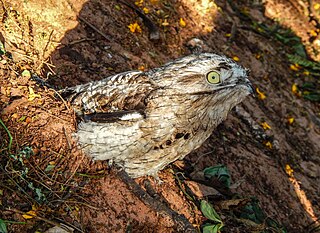
The common potoo, or poor-me-ones, or urutau is one of seven species of birds within the genus Nyctibius. It is notable for its large, yellow eyes and a wide mouth. Potoos are nocturnal and are related to nightjars and frogmouths. They lack the characteristic bristles around the mouths of true nightjars.

The Tuamotu sandpiper is an endangered member of the large wader family Scolopacidae, that is endemic to the Tuamotu Islands in French Polynesia. It is sometimes placed in the monotypic genus Aechmorhynchus. A native name, apparently in the Tuamotuan language, is kivi-kivi.

The neotropic cormorant or olivaceous cormorant is a medium-sized cormorant found throughout the American tropics and subtropics, from the middle Rio Grande and the Gulf and Californian coasts of the United States south through Mexico and Central America to southern South America, where it is called by the indigenous name of biguá. It also breeds in the Bahamas, Cuba, and Trinidad. It can be found both on coasts and in inland waters. There are at least two subspecies: N. b. mexicanum from Nicaragua northwards and N. b. brasilianum further south. In Peru, the neotropic cormorant is used by the Uru people for fishing.

The whiskered auklet is a small seabird of the auk family. It has a more restricted range than other members of its genus, Aethia, living only around the Aleutian Islands and on some islands off Siberia, and breeding on these islands. It is one of the smallest alcids, only the closely related least auklet being smaller. Its name is derived from the long white feathers on its face that are part of its breeding plumage.

The wandering tattler, is a medium-sized wading bird. It is similar in appearance to the closely related gray-tailed tattler, T. brevipes. The tattlers are unique among the species of Tringa for having unpatterned, greyish wings and backs, and a scaly breast pattern extending more or less onto the belly in breeding plumage, in which both also have a rather prominent supercilium.

The great potoo or grand potoo is the largest potoo species and is widely distributed in Central and South America.
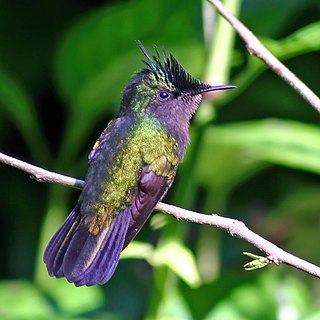
The Antillean crested hummingbird is a species of hummingbird in the family Trochilidae. Found across Anguilla, Antigua and Barbuda, Barbados, Dominica, Grenada, Guadeloupe, Martinique, Montserrat, north-east Puerto Rico, Saba, Saint-Barthélemy, Saint Kitts and Nevis, Saint Lucia, Saint Martin, Saint Vincent and the Grenadines, Sint Eustatius, the British Virgin Islands, the U.S. Virgin Islands, and the Lesser Antilles, while it has also been recorded as a vagrant in Florida, USA.

The stripe-backed bittern is a bird species belonging to the family Ardeidae, which includes Herons, Egrets and Bitterns. Commonly found near freshwater swamps, marshes, lake shores and streams, stripe-backed bitterns span over a wide distribution that divides into the northern and southern populations, spanning on both sides of the Andes. Although increasingly recognized and researched worldwide, much life history details are lacking concerning this species, which remains understudied compared to its similar looking sister clade, including the least bittern.

The black-backed bittern, also known as the black-backed least bittern or Australian little bittern, is a little-known species of heron in the family Ardeidae found in Australia and vagrant to southern New Guinea. Formerly lumped with the little bittern, it is one of the smallest herons in the world.

The Hawaiʻi ʻelepaio, also Hawaiian ʻelepaio, is a monarch flycatcher found on the Big Island of Hawaii. Until 2010, all three ʻelepaio species, the Kauaʻi ʻelepaio, the Oʻahu ʻelepaio and this species were considered conspecific.

